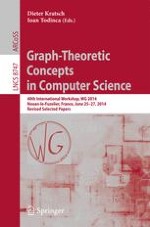This book constitutes the thoroughly refereed post-conference proceedings of the 40th International Workshop on Graph-Theoretic Concepts in Computer Science, WG 2014, held in Nouan-le-Fuzelier, France, in June 2014.
The 32 revised full papers presented were carefully reviewed and selected from 80 submissions. The book also includes two invited papers. The papers cover a wide range of topics in graph theory related to computer science, such as design and analysis of sequential, parallel, randomized, parameterized and distributed graph and network algorithms; structural graph theory with algorithmic or complexity applications; computational complexity of graph and network problems; graph grammars, graph rewriting systems and graph modeling; graph drawing and layouts; computational geometry; random graphs and models of the web and scale-free networks; and support of these concepts by suitable implementations and applications.
